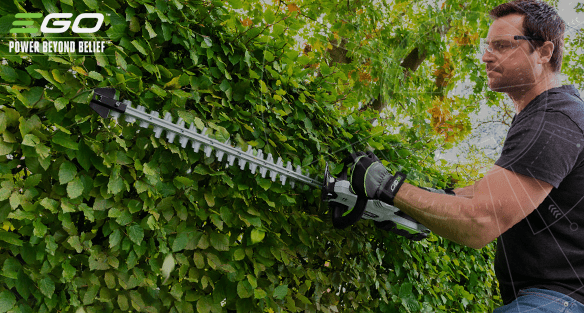Recently, we published a guide on getting your hedge into shape during the spring. It includes a whole host of other useful information too.
However, with the best will in the world, it’s sometimes impossible to stick to nature’s timetable, and you might find you need to power up the cordless hedge trimmer.
- Maybe the sun and rain have prompted a growth spurt that means your hedge is overshadowing other plants. This is more likely if you have a conifer, which grows faster than an evergreen
- You might like a formal hedge, maintaining clean lines and shapes
- Or perhaps you’d like to do some landscaping around your hedge, so it needs cutting back to create space for you to work and build
Whatever the reason, here are our tips for handling your hedge with sensitivity and care, so it continues to bless your garden with good lines and attractive flowers.
First, the basics
- All hedge species will require a trim at least once a year
- Do the first trim after the first flowering.
- Your hedge will only flower if it’s been trimmed the previous year to encourage bud growth.
- Some hedge species respond well to hard pruning, whereas others won’t grow from pruned branches.
- Summer trimming might encourage a fungal infection in some species.
What species of hedge do you have?
Hedges are much more than hawthorn, conifer or leylandii. The Royal Horticultural Society has put together an extensive list of beautiful hedge plants suitable for every taste, purpose and soil type, including native plants.
Plants suitable for hedges include plants from the hebe and ilex families, laurel, rhododendron, sea buckthorn, holly, hornbeam, beech, yew and sloe.
Many have flowers and berries; some have thorns. Some will grow to great heights if left unchecked; others are slower-growing or dwarf hedges.
Types of hedge plant
There are two types: evergreen and deciduous.
- Evergreens like conifers offer colour, shelter and privacy all year round. Unless you’re letting them go wild on purpose, you’ll probably need to keep their growth in check by trimming them twice a year.
- Deciduous plants like beech add variety, colour and diversity to your garden. They don’t mind too much if you use the hedge trimmer in summer - in fact, for several species, late summer is the optimal time for trimming.
How to cut your hedge in summer
- There are two ways to cut a hedge: formative and maintenance.
- Formative is a term for more dramatic reshaping, especially of formal hedging.
- Maintenance means what it sounds like - a trim to keep it in shape and healthy.
- Formative is best for the cooler months, so if you have to trim in summer, go lightly. If certain species of evergreen are over-trimmed, like leylandii, they won’t recover their good looks.
- For advice on the most accurate way to trim your hedge, google your specific species. If you don’t know the species of your hedge, The Woodland Trust has a handy app to help.
- Choose a cordless hedge trimmer with a strong blade and a tooth depth that can handle mature deciduous branches.
- Trimming new growth on the outside is known as a ‘heading cut’.
- Use secateurs to create air and light inside the dense body of the hedge - known as a ‘thinning cut’, which removes a stem or branch right back to the trunk.
- Start at the bottom and trim your way up, finishing with the top.
- Don’t forget - safety first! Wear protective clothing against flying debris and potentially irritating sap. Check your safety manual for full details and recommendations.
Birds nests in hedges are protected in the UK
In the late spring or early summer, you might discover that birds have nested in your hedge.
In fact, this is something you’ll need to check before you switch on your cordless hedge trimmer, because you have a legal responsibility.
The Wildlife & Countryside Act 1981 states it’s illegal to damage or destroy a nest of any wild bird while it’s in use or being built).
If you do find a nest, you’ll have to reschedule until the nest has been vacated, which will certainly be by late summer.
On the up side, watching the fledglings grow up is something your children and grandchildren will love to watch!
Battery hedge trimmers
Light, ergonomic and durable, our hedge trimmers are cordless, quieter, give off less vibration and emit zero emissions. Our battery-powered hedge trimmers have cutting lengths ranging from 51cm to 75cm, and available across our Power+, Professional and Professional-X range.
If you’re in the market for grass shears/shrub trimmers, then we’ve got just the tool for you. The CHT2001E has a 20cm blade length with the shrub shear attachment. The 11.5cm wide grass trimmer attachment is ideal for neatening up smaller areas and will run for up to 70 minutes on the 12V battery which is provided with them.
Get yourself ready for hedge cutting season and check out our range - there’s a cordless hedge trimmer for every size of garden, allotment or public park.
